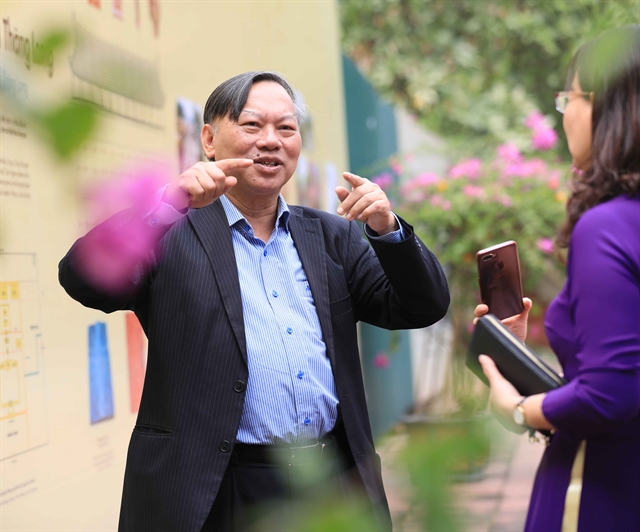
KEEN MIND: Professor Nguyễn Quang Ngọc talks passionately about his research into Hà Nội. VNA/VNS Photo Thanh Tùng
Nguyễn Quang Ngọc was born on September 14, 1952, to a farming family in Hải Phòng City. He has released many books on history and is currently working as the director of the Centre for Hà Nội Studies and Capital Development, vice chairman of the Việt Nam Association of Historical Science, and head of the Vietnamese cultural history faculty at the Hà Nội National University.
Inner Sanctum: How did you become an expert in history, after starting out in mathematics?
I was indeed interested in mathematics. In 1969, after I graduated from high school, I didn’t know which university to apply to. One day, by chance, I heard about Prof Ngụy Như Kon Tum on the radio. He was a leading scientist and that time and was the dean of the Hà Nội National University. He inspired me to learn about the university, and I was then determined to study maths there.
When I arrived at the university to start the school year, however, I was disappointed to find that somehow I was listed in the history faculty. I immediately asked to change to the maths faculty. But I had to study history for a few days before they made the change.
My first teacher was Prof Trần Quốc Vượng, one of the founders of Vietnamese history studies. His lessons were so fascinating that I shelved my plans to study maths and decided to pursue history.
Inner Sanctum: Of the dozens of research projects you have conducted, which one is the most memorable?
One of the most important milestones in my life was my graduate thesis on the seat of the Tây Sơn Dynasty (1771-1802). With the guidance of Prof Phan Huy Lê, I travelled to the south-central province of Bình Định to explore and research.
You can scarcely imagine how difficult and even dangerous research conditions were back in 1977, as the south had only recently been liberated.
To survey the historical vestiges, I stayed there for several months. I climbed Ông Bình Mountain, where the Tây Sơn insurgent troops were stationed, searched around An Khê Pass, and entered the forest where the Dark and Tiger caves are found. These names reveal the danger and difficulty of working at these sites.
My research was highly regarded by my teachers, and I uncovered many historical facts that were believed to no longer exist.
Inner Sanctum: You also conducted important research on the Hoàng Sa (Paracel) and Trường Sa (Spratly) Islands. What can you tell us about that?
It was a long-term effort, and ended up taking a quarter of a century to complete. When I was assigned the project, I was 40 years old and had completed my PhD. But this topic was huge.
I spent a lot of time searching through countless local and foreign documents and bibliographies, headed out on field trips, and read books to gain a broad, thorough perspective on the topic.
At that time, locating documents was extremely difficult, especially archival documents. And then, when I had finished, no one would agree to print all of it.
Frustrated, I continued the work and deepened my research. It was not until 2017 that the National University Publishing House had some special reference books and asked me about printing mine. I brought all of my work together and completed the book, Hoàng Sa, Trường Sa -- Chủ quyền của Việt Nam: Tư liệu và sự thật lịch sử (Paracels and Spratlys -- Việt Nam’s Sovereignty: Historical Documents and Facts).
My teacher, Prof Lê, evaluated it as “the most elaborate and systematic research work ever”. The Ministry of Information and Communications then arranged a translation and it was released in English. The Vietnamese version was republished many times. It became the proudest achievement of my career.
Inner Sanctum: You now work in different positions. Do you have any tips on researching a topic effectively?
First, I work with passion. Second, I am fortunate to have students, associates, and enthusiastic young people who have supported me a great deal.
If I was to give advice to young people, I would say keep learning. I spent my youth learning. In order to conduct my research, I also studied linguistics, geography, foreign languages, and old scripts. Perhaps the knowledge accumulated from my younger days helped me handle a lot of the work I had when I was older.
Inner Sanctum: You have been honoured as an exemplary citizen of the capital Hà Nội. How do you feel about the recognition?
I was surprised. Though I have completed many works on Hà Nội and participated in important projects for the capital city, such as compiling a dossier for nominating Thăng Long Citadel as a UNESCO World Heritage Site, I didn’t think that one day I would receive this title, because I am not originally Hanoian.
The honour makes me feel as though I have to try harder, and I firmly believe that Hà Nội will always be an inspiration for researchers to promote the traditions of the thousand-year-old cultural capital, the City for Peace, and the UNESCO Creative City. VNS
OVietnam